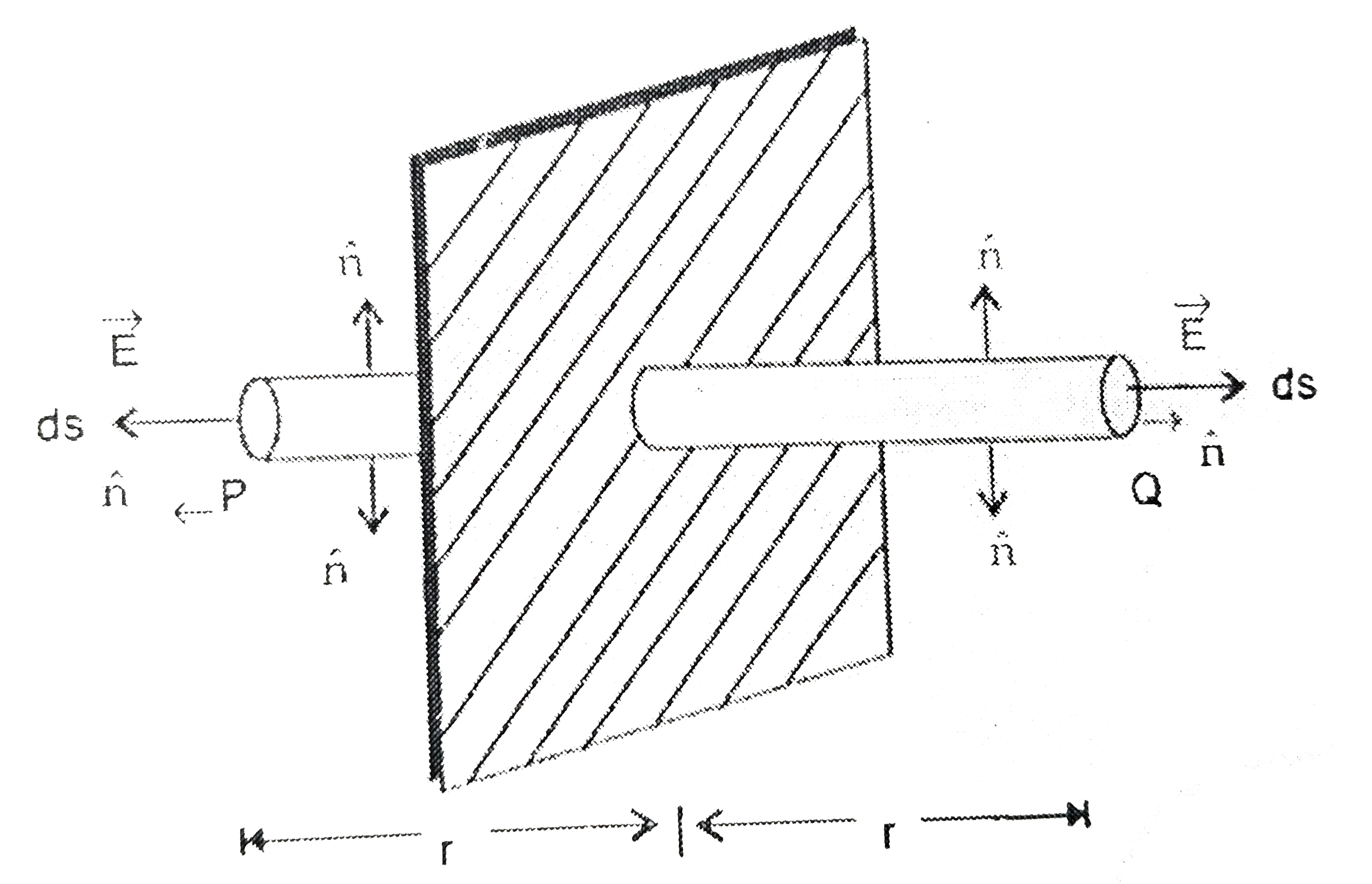State Gauss's law in electrostatics. Using this law derive an expression for the electric field due to a uniformly charged infinite plane sheet.
Electric field due to a uniformly charged infinite plane sheet : Suppose a thin non-conducting infinite sheet of uniform surface, charge density σ.
Electric field intensity on either side of the sheet must be perpendicular to the plane of sheet having same magnitude at all points equidistant from sheet.
Let P be any point at a distance r from the sheet.
Let the small area element →E=dsˆn
→Eandˆn are perpendicular, on the surface of imagined cylinder, so electric flux is zero.
→Eandˆn are parallel on the two cylindrical edges P and Q, which contributes electric flux.
∴ Electric flux over the edges P and Q of the cylinder is
2ϕ=q∈0⇒2∮→E.→ds=q∈0 [∵ϕ=∮→E.dec(ds)]

2∮→E.→ds=q∈0
2∮Eds=q∈0 [∵→E⊥→ds]
2Eπr2=q∈0⇒E=q2π∈0r2
∴ The charge density σ=qS⇒q=πr2σ [where S-area of circle]
E=πr2σ2π∈0r2E=σ2∈0 ∴ vecotrically →E=σ2∈0ˆn
where ˆn is a unit vector normal to the plane and going away from it.
When σ>0, E is directed away from both sides. Hence electric field intensity is independent of r.
When σ>0, E is directed away from both sides. Hence electric field intensity is independent of r.
Note : For conducting sheet, the surface charge density on both the surface of sheet will be same
∴E=σ∈0
Topper's Solved these Questions
- BOOK - XII BOARD PREVIOUS YEAR PAPER ENGLISHCHAPTER - XII BOARDSEXERCISE - SET III7videos
XII BOARDS
- BOOK - XII BOARD PREVIOUS YEAR PAPER ENGLISHCHAPTER - XII BOARDSEXERCISE - SET-III22videos
XII BOARDS
- BOOK - XII BOARD PREVIOUS YEAR PAPER ENGLISHCHAPTER - XII BOARDSEXERCISE - SET I54videos
XII BOARDS
- BOOK - XII BOARD PREVIOUS YEAR PAPER ENGLISHCHAPTER - SAMPLE PAPER 2019EXERCISE - SECTION D6videos
SAMPLE PAPER 2019
Similar Questions
State Gauss's law in electrostatics. Use this law to derive an expression for the electric field due to an infinitely long straight wire of linear charge density λcm−1
View SolutionAnswer the following:
State Gauss' law in electrostatics. Derive an expression for the electric field due to an infinitely long straight uniformly charged wire.View SolutionUsing Gauss’ law, derive an expression for the electric field at a point near an infinitely long straight uniformly charged wire.
View Solution(a) Use Gauss's law to derive the expression for the electric filed (→E) due to straight uniformaly charges infinite line of charges density λC/m.
(b) Draw a graph to show the variation of E with perpendicular from the line of charge.
(c) Find the work done in brining a charge q from prependicular distance r1 to r2(r2>r1).View SolutionState Gauss's theorem in electrostatics. Apply this theorem to derive an expression for electric field intensity at a point outside a uniformly charged thin spherical shell.
View SolutionAnswer the following:
(a) State Gauss' law. Using this law, obtain the expression for the electric field due to an infinitely long straight conductor of linear charge density λ.
(b) A wire AB of length L has linear charge density λ=kx, where x is measured from the end A of the wire.
This wire is enclosed by a Gaussian hollow surface. Find the expression for the electric flux through this surface.View SolutionDerive an expression for electric field intensity at a point due to point charge.
View Solution(a) Define electric flux. Write its S.I. units.
(b) Using Gauss's law, prove that the electric field at a point due to a uniformly charged infinite plane sheet is independent of the distance from it.
(c ) How is the field directed if (i) the sheet is positively charged, (ii) negatively charged ?View SolutionUsing Gauss's law obtain the expression for the electric field due to uniformly charged thin spherical shell of radius R at a point outside the shell. Draw a graph showing the variation of electric tield with r, for r gt R and r lt R.
View SolutionUsing Gauss's law obtain the expression for the electric field due to uniformly charged thin spherical shell of radius R at a point outside the shell. Draw a graph showing the variation of electric tield with r, for r gt R and r lt R.
View Solution

